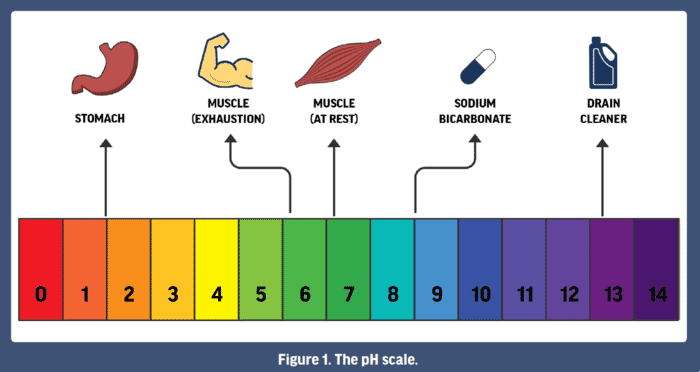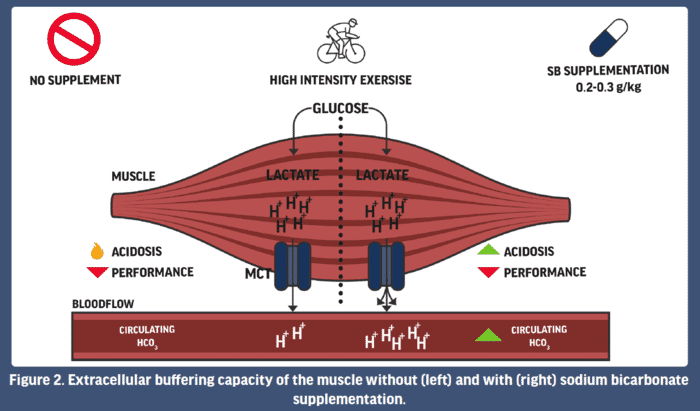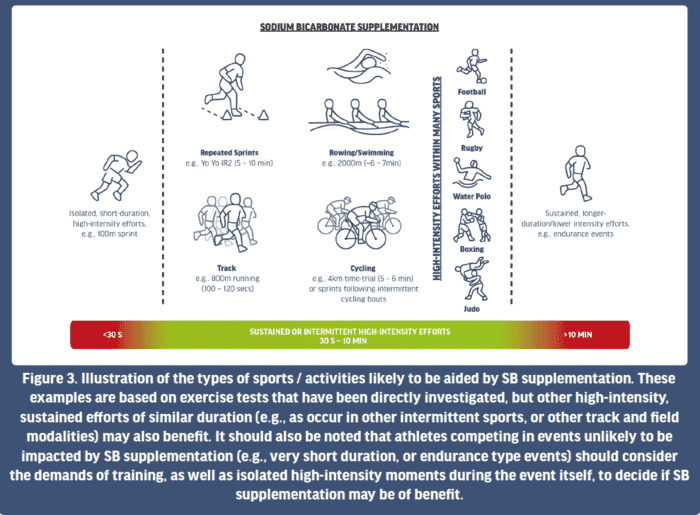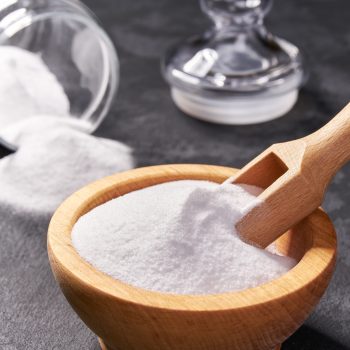Most of us recognise sodium bicarbonate as baking powder and are aware of its many uses in the kitchen. What we probably don't know, however, is how it can also be used as a supplement and the surprising benefits it can have to an athlete.
In our latest X-Change paper, Felipe Marticorena, Eimear Dolan and Bryan Saunders give the lowdown on sodium bicarbonate as a sports supplement, explaining how it can actually enhance sporting performance. They will also shed some light on how supplementation works, what kind of activity it benefits and how you should be taking it.
Read the paper in full below or click the button to download as a PDF.
Sodium Bicarbonate: More Than Just Baking Powder
Practical Implications
- High-intensity exercise can lead to an increase in hydrogen ion (H+) accumulation, causing a reduction in muscle pH (acidosis) which negatively impacts performance via a range of mechanisms, including reducing the capacity for muscle contraction and slowing the rate of ATP regeneration.
- Sodium bicarbonate is a salt formed by a sodium cation and a bicarbonate anion, forming NaHCO3-.
- Sodium bicarbonate supplementation increases blood bicarbonate concentration which increases transport of H+ out of the muscle, allowing better regulation of muscle pH and thus increasing capacity to undertake high intensity exercise.
- Sodium bicarbonate supplementation improves exercise performance with its greatest effect during high-intensity exercise lasting ~1-10 min duration.
- Supplementation with sodium bicarbonate throughout training periods may lead to greater adaptations than training alone.
- Side-effects can occur following supplementation, and include gastrointestinal discomfort, headache, nausea and even vomiting.
- 0.2 - 0.3 g/kg of sodium bicarbonate approximately 60–180 min prior to exercise seems to be optimal for performance gains.
Background
You have probably heard that sodium bicarbonate (SB) can be used in a wide variety of situations, such as baking, cleaning, gastritis relief, or even middle-school chemistry experiments, but that this substance is widely used as a sport supplement to enhance performance may be less well known. In fact, SB is considered by the International Olympic Committee as one of just 5 sport supplements with sufficient evidence to support its use in certain sport-specific scenarios (with the other 4 being creatine, caffeine, nitrate and beta alanine) [1]. In this article we will elucidate how sodium bicarbonate supplementation works, what type of activity it benefits most and recommended dosing strategies.
Why do Your Muscles Burn During Exercise?
The human organism is a complex and well orchestrated system composed of thousands of cells, proteins, and enzymes. For this system to work optimally, we rely on our body to provide an optimal environment, including temperature, oxygenation, and pH. The pH is a quantitative scale to measure how acid or basic/alkaline a solution is, and ranges from 0 (most acidic) to 14 (most alkaline) (Figure 1).

Human muscle has a pH of approximately 7.1, but this can be reduced to as low as 6.1 following high intensity exercises [2]. This acidosis is caused by the accumulation of H+ due to an increasing energy demand of the muscle particularly from anaerobic glycolysis, which is a powerful system that supplies energy during high intensity exercises [2]. The buildup of H+ that impairs several crucial enzymes that are working hard inside the muscle cells to provide energy [3], directly interferes with the muscles’ ability to contract [4] and stimulates the burning sensation felt in the working muscles through the activation of acid-sensitive ion channels (ASIC) family [5]. Luckily, the body has developed several physiological systems that work to combat the negative effect of muscle acidosis.
H+ Buffering
The human body has evolved to deal with the muscular acidosis that occurs during high-intensity exercise via highly developed intracellular (within the muscle) and extracellular (within the blood) buffering systems. Intracellular buffers such as carnosine (see Nutrition X-change volume 3), represent the muscle’s immediate defense against H+ accumulation in the exercising muscle. Muscle pH homeostasis is also maintained by transport of H+ out of the muscle into the blood primarily via monocarboxylate transporter 1 (MCT1) and 4 (MCT4) (Figure 2) [6] which can facilitate the removal of H+ from the muscle into the blood. In the blood, the buffering system is primarily composed of circulating bicarbonate (HCO3-), which can bind the H+ to form carbonic acid and ultimately water and carbon dioxide which can then be released into the environment when you breathe [7]. Nutritional interventions that can increase transport of the H+ produced in the muscle into the blood, thereby indirectly increases pH buffering of the muscle, could lead to improvements during exercise that is limited by muscle acidosis.

How Does SB work?
When high-intensity exercise starts without any prior supplementation, the H+ generated from the energy demand accumulates in the muscle, with transport out of the muscle limited by the normal activity of the transports systems, including the MCTs. The efflux of H+ out of the muscle is soon overwhelmed as exercise continues; this scenario leads to muscular acidosis, which as discussed impairs several physiological mechanisms and ultimately performance. However, if this same exercise task is performed following SB supplementation, then we have an increased amount of circulating bicarbonate in the blood which will increase the pH gradient between muscle and blood leading to an increased activity of the MCT transporters [6]. This leads to an increased movement of H+ out of the muscle and consequently better maintenance of the intramuscular pH milieu, which would minimise the detrimental effect that H+ accumulation has within the muscle and could lead to an improved performance.
Effects of SB on exercise outcomes
Many supplements have a mechanistic rationale to improve performance but when tested in the real world, expected results are not achieved. So, does SB supplementation live up to the hype? In general, it would certainly appear so. Meta-analysis is a useful scientific tool that provides a statistical analysis that combines data from several research articles to reach a consensus on whether an intervention is effective or not. Several meta-analyses over the last 30 years have consistently demonstrated a positive effect of SB on exercise outcomes [8, 9, 10]. A meta-analysis from Peart and colleagues (2012) demonstrated a moderate overall effect of SB supplementation on performance outcomes. Another meta-analysis from Carr et al. (2011) also found a moderate enhancement of exercise performance with SB, showing a 1.7±2.0% performance improvement. The difference in medal ranking in events of several Olympic sports can be separated by less than 1%. Thus, translating these data to the real world, this suggests that supplementation with SB could lead to important performance improvements for competitive athletes. The results from these cited meta-analyses are
important to know that SB supplementation can lead to improvements in exercise outcomes at the group level, however, it is also important to understand that these effects may vary from person to person. As such, a better understanding of different factors that may modify the size of these gains can lead to more targeted recommendations, in turn, increasing the likelihood of a successful outcome. For example, despite showing an overall benefit of SB for exercise performance, the meta-analysis of Peart et al. (2011) showed an inverse relationship between the size of the effect and training status, which means that the more trained the individual, the smaller the effect of supplementation. This is a common finding with nutritional supplements and may be due to the adaptations associated with chronic training that minimise any effect of a supplement. Other factors may also modify the response to SB supplementation [11] and include:
- Dose: 0.1 g/kg appears to be too low to induce performance improvements, while 0.4-0.5 g/kg might generate more gastrointestinal discomfort without further exercise improvements [12]. A 0.2–0.3 g/kg is currently considered to be the optimal
dose [13]. - Timing: The timing of ingestion before exercise is important because it directly influences the amount of circulating bicarbonate. Coinciding exercise with peak blood bicarbonate levels may optimise your chances of a benefit from supplementation [13,14] although data suggest that bicarbonate peaks and plateaus for a substantial period following supplementation (60–180 min) [15] meaning ingestion anytime 1-3 hours prior to exercise should lead to similar benefits.
- Duration and Intensity of exercise: High intensity exercise lasting 1-10 min is likely to generate large H+ accumulation and appears most susceptible to improvements with SB [11] (Figure 3). This includes, but is not limited to, 100m and 200m swimming, 4-km cycling and 2000m rowing. There is also evidence to suggest that prolonged intermittent activity, such as team sports or even endurance cycling, might benefit from SB during maximal or near-maximal efforts [16]. SB may even improve muscular endurance, but not muscular strength [17].

Most studies have investigated the effect of acute SB supplementation on isolated exercise tests, demonstrating its efficacy to directly influence performance particularly during high-intensity exercise 1–10 min in duration. However, it is important to note that SB may also be considered an effective supplement to ingest chronically throughout a training program to optimise gains and performance. For example, one study showed that SB supplementation (0.4 g/kg) prior to each high intensity training session of an 8-week structured training intervention led to greater improvements in endurance performance than training alone. Thus, SB can be considered an effective supplement to incorporate not only directly prior to competition, but throughout training to optimise gains.
How and When Should You Take it?
The supplementation strategy for SB should be performed acutely, that is, a single dose before exercise. The two most important variables when dealing with acute supplementation protocols appear to be timing and dose, as these can directly influence the size of the performance effect of supplementation. Regarding the dose, there is a direct relationship between how much SB is being ingested and the extent of blood alkalosis, which appears to relate well to performance improvements [11], but no additional performance gains are evident when exceeding 0.3 g/kg of SB [12]. Studies show that the ideal range of elevated bicarbonate in the bloodstream to promote improved performance is >5 mmol·L-1 [11], and evidence suggests this is consistently achieved by supplementing 0.3 g/kg of SB. As an example, for a 70kg individual, this equates to 70 x 0.3g = 21g of SB to reach this ergogenic range. The supplement can either be ingested diluted in water (preferably with some non-caloric and non-acidic flavouring to improve the salty taste) or in gelatine capsules. A standard sized capsule can hold approximately 1g of SB, meaning that you need to ingest ~20 of these to attain recommended dose. Studies have shown that individualising supplement timing to ensure exercise begins at the moment of peak blood bicarbonate concentration is effective to improve performance [13, 18]. More recently Boegman and colleagues [14] demonstrated that rowers showed a very small but significant improvement in 2000m time-trial performance when individualising bicarbonate supplementation to time-to-peak compared to a standardised time (60 min). This difference might be worthwhile in a competitive setting although more work is needed to determine if a time-to-peak strategy is truly worthwhile. In the real world however, most athletes do not have access to equipment that will allow them to determine their individual blood bicarbonate response following supplementation. Luckily, work from our group suggests that identifying a solitary peak may not be necessary as it appears that there is a large window of opportunity during which SB remains above >5 mmol/L and around peak values [15]. These data indicate that supplement ingestion should occur 60–180 min prior to the moment at which increased buffering capacity is required. Recently, other forms of administration have emerged, such as the topical application of bicarbonate. However, the only study testing this product to date did not show any changes in buffering capacity or performance benefits with topical sodium bicarbonate lotion [19]. Current evidence does not support the use of topical sodium bicarbonate.
Are there any side-effects to worry about?
When ingesting SB, we are adding a basic solution to a highly acidic environment in the stomach. Part of the ingested bicarbonate neutralizes the stomach acid, and this can generate gastric discomfort, a sensation of bloating and eructation (burping). Moreover, diarrhoea can occur after the administration of SB, mainly due to sodium residuals that reach the intestine which favour the attraction of water molecules to the intestinal region, increasing peristaltic bowel movements. These symptoms could negate any benefit of increased buffering capacity via supplementation, and can even be ergolytic to performance (i.e. worsen performance) [20]. Nonetheless, most studies suggest that incidence and intensity of these symptoms are low [21]. The incidence of these symptoms appears variable between, and even within, individuals [22] and anyone planning to use SB should proceed with caution and consider the necessity of SB supplementation according to the importance of the subsequent exercise (for example, athletes may preferentially supplement during training as opposed to prior to competition, to avoid side-effects affecting their competitive edge). Scientific research is currently attempting to determine methods by which to minimise the uncomfortable symptoms that can occur following SB ingestion. One of the main alternatives that has emerged in the search to reduce these symptoms is the administration of SB in gastro-resistant capsules [23]. This is because gastro-resistant capsules avoid disintegration in the stomach, preventing the neutralization of stomach acids and, consequently, reducing some of the symptoms mentioned above. Some studies showed attenuated symptoms following SB supplementation in these types of capsule, although there was a delayed response in the time-to-peak of bicarbonate in the bloodstream that should be considered (120 vs. 70 min). This strategy might modify the ideal timing of supplementation prior to exercise, while performance effects need to be investigated as no study has yet investigated SB in gastro-resistant capsules on exercise outcomes.
Summary
There are few nutritional supplements considered to be effective for athletes, but SB is certainly one of them. An individualized dose of 0.2 – 0.3g/kg is enough to increase circulating bicarbonate to optimal levels for approximately 60–180 min post-ingestion. This increases the buffering capacity of the body, which may optimize muscle function and improve exercise performance in a variety of exercises, such as short distance swimming, rowing, cycling sprints and intermittent exercises like football. Although there are some side-effects to consider, evidence to support the use of SB supplementation for athletic performance is strong.
References
1. Maughan RJ, Burke LM, Dvorak J, Larson-Meyer DE, Peeling P, Phillips SM, et al. IOC consensus statement: Dietary supplements and the high-performance athlete. Br J Sports Med. 2018;52:439–55.
2. Pan J, Hamm J, Hetherington H, Rothman D, Shulman R. Correlation of lactate and pH in human skeletal muscle after exercise by 1H NMR. Magnestic Reson Med. 1991;20:57–65.
3. Robergs RA. Biochemistry of exercise-induced metabolic acidosis. AJP Regul Integr Comp Physiol. 2004;287:R502–16.
4. Jarvis K, Woodward M, Debold EP, Walcott S. Acidosis affects muscle contraction by slowing the rates myosin attaches to and detaches from actin. Journal of muscle research and cell motility. 2018 Oct 31.
5. Philp A, Macdonald AL, Watt PW. Lactate--a signal coordinating cell and systemic function. J Exp Biol. 2005 Dec;208(Pt 24):4561-75.
6. Juel C. Regulation of pH in human skeletal muscle: adaptations to physical activity. Acta Physiol (Oxf). 2008;193:17–24.
7. Robergs RA. Biochemistry of exercise-induced metabolic acidosis. AJP Regul Integr Comp Physiol. 2004;287:R502–16.
8. Matson LG, Tran ZV. Effects of sodium bicarbonate ingestion on anaerobic performance: a meta-analytic review. Int J Sport Nutr. (1993) 3:2–28.
9. Peart DJ, Siegler JC, Vince RV. Practical recommendations for coaches and athletes: a metaanalysis of sodium bicarbonate use for athletic performance. J Strength Cond Res. (2012) 26:1975–83.
10. Carr AJ, Slater GJ, Gore CJ, Dawson B, Burke LM. Effect of sodium bicarbonate on [HCO− 3 ], pH, and gastrointestinal symptoms. Int J Sport Nutr Exerc Metab. (2011) 21:189–94.
11. Heibel AB, Perim PH, Oliveira LF, McNaughton LR, Saunders B. Time to optimize supplementation: modifying factors influencing the individual responses to extracellular buffering agents. Front Nutr. (2018) 5:35.
12. McNaughton LR. Bicarbonate ingestion: effects of dosage on 60 s cycle ergometry. J Sports Sci. (1992) 10:415–23.
13. Gough LA, Deb SK, Sparks SA, McNaughton LR. Sodium bicarbonate improves 4 km time trial cycling performance when individualised to time to peak blood bicarbonate in trained male cyclists. J Sports Sci. 2017 Nov 29:1-8.
14. Boegman S, Stellingwerff T, Shaw G, Clarke N, Graham K, Cross R, et al. The Impact of Individualizing Sodium Bicarbonate Supplementation Strategies on World- Class Rowing Performance. Front Nutr. 2020;7(138).
15. Oliveira L, Saunders B, Yamaguchi G, Swinton P, Giannini Artioli G. Is Individualization of Sodium Bicarbonate Ingestion Based on Time to Peak Necessary? Med Sci Sports Exerc. 2020 Aug;52(8):1801-1808.
16. Dalle S, Koppo K, Hespel P. Sodium bicarbonate improves sprint performance in endurance cycling. J Sci Med Sport. 2021;24(3):301-6.
17. Grgic, J., Rodriguez, R. F., Garofolini, A., Saunders, B., Bishop, D. J., Schoenfeld, B. J., & Pedisic, Z. (2020). Effects of Sodium Bicarbonate Supplementation on Muscular Strength and Endurance: A Systematic Review and Meta-analysis. Sports Med, 50(7), 1361-1375.
18. Miller P, Robinson AL, Sparks SA, Bridge CA, Bentley DJ, McNaughton LR. The effects of novel ingestion of sodium bicarbonate on repeated sprint ability. J Strength Cond Res. (2016) 30:561–8.
19. McKay AKA, Peeling P, Binnie MJ, Goods PSR, Sim M, Cross R, et al. Topical Sodium Bicarbonate: No Improvement in Blood Buffering Capacity or Exercise Performance. Int J Sports Physiol Perform. 2020:1-7.
20. Saunders B, Sale C, Harris RC, Sunderland C. Sodium bicarbonate and high-intensity-cycling capacity: variability in responses. Int J Sports Physiol Perform. (2014) 9:627–32.
21. Gough LA, Deb SK, Sparks AS, McNaughton LR. The Reproducibility of Blood Acid Base Responses in Male Collegiate Athletes Following Individualised Doses of Sodium Bicarbonate: A Randomised Controlled Crossover Study. Sports Med. 2017 Oct;47(10):2117-2127.
22. de Araujo Dias G, da Eira Silva V, Painelli VS, Sale C, Giannini Artioli G, Gualano B, et al. (In)consistencies in responses to sodium bicarbonate supplementation: a randomised, repeated measures, counterbalanced and double-blind study. PLoS ONE (2015) 10:e0143086
23. Hilton NP, Leach NK, Sparks SA, Gough LA, Craig MM, Deb SK, McNaughton LR. A Novel Ingestion Strategy for Sodium Bicarbonate Supplementation in a Delayed- Release Form: a Randomised Crossover Study in Trained Males. Sports Med Open. 2019 Jan 24;5(1):4.




